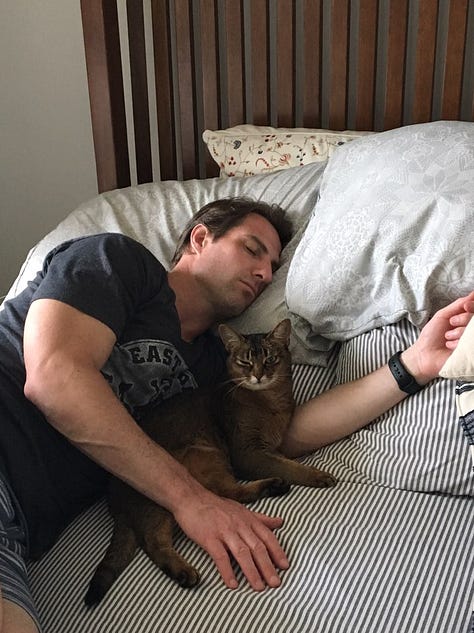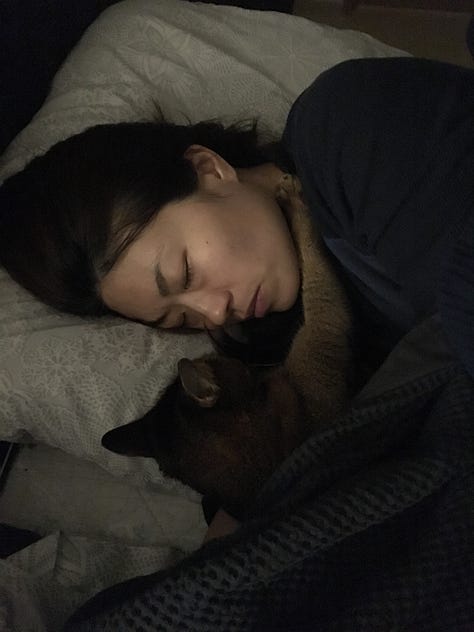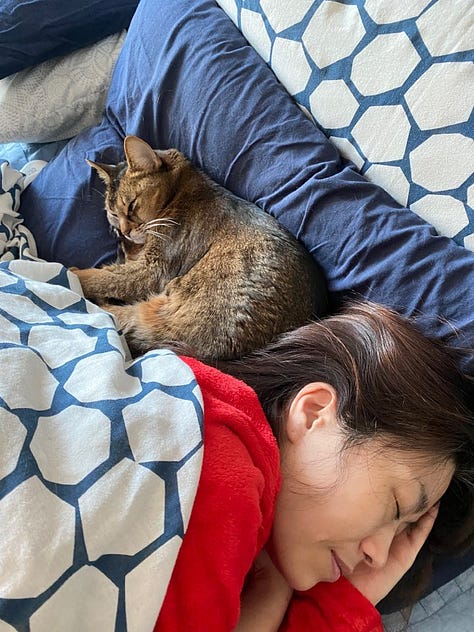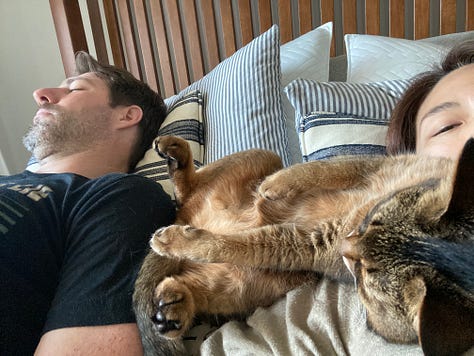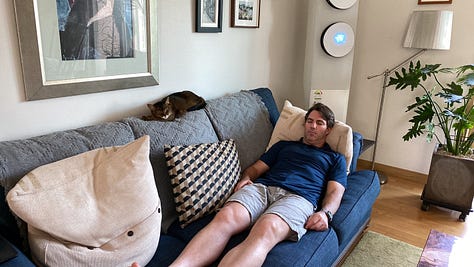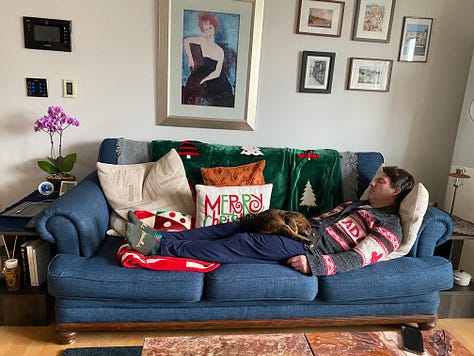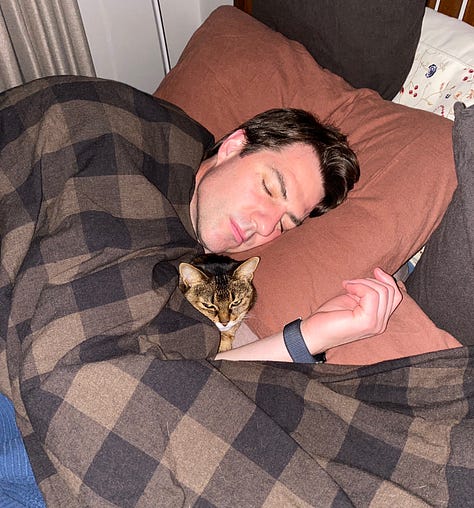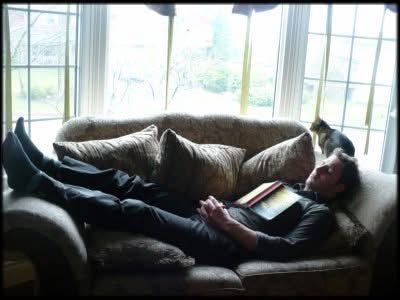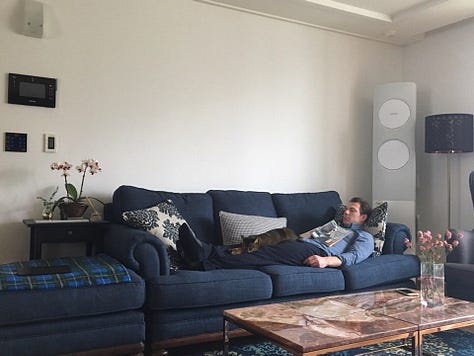This post continues from Part 1: Go to Sleep—Don’t Fall Asleep, where I made the case for sleep as one of the most underrated powers in your life. Here, I get practical—how I structure my nights, why it matters, and how you can rethink sleep as a skill to be trained, not a surrender to exhaustion.
You already know why sleep matters. If you’ve read Part 1, you’ve felt the problem in your bones. You’ve lived it: the heavy eyes, the irritable mornings, the joyless afternoons. The dull haze you call a day. And maybe you’ve even decided to do something about it.
This is the part where that decision becomes real. Where we shift from knowing to doing. Because sleep doesn’t just happen. It is something you practice.
And it matters more than you think.
I spent years walking through the day tired—not always exhausted, but not really alive either. And when I recently had a rare day where I felt sleepy during class, the contrast shocked me. I remembered, almost in horror, that I used to feel like that all the time. It was horrible. But it also felt good—because it reminded me how far I’d come. That sense of vitality I feel now? That’s normal. That’s how life is meant to be.
It doesn't have to be like that. You must only claim it.
Sleep Builds Everything Else
And let’s be clear: this isn’t just about how you feel. Sleep touches everything—especially your body. If you care about fat loss, body composition, energy, recovery, cognitive clarity, emotional regulation—sleep is doing half the work. People put enormous effort into dieting or exercising, and then sabotage it by skimping on rest.
Core and deep sleep play major roles in metabolic health and hormonal balance. Without them, your body is in a constant low-grade stress state. You don’t burn fat efficiently. You don’t build muscle well. And your willpower—the thing you’re relying on to make better choices? That’s shot too.
This is also how sleep connects to stress. When you’re well-rested, you cope. You regulate. You respond. When you’re tired, you react. You snap. You spiral.
Prepare to Be Fully Present for the Sleeping Task at Hand
This is why I always come back to a core principle from Win the Shift You’re In. You need to be present for whatever moment you're in—and presence starts with readiness. You can’t engage your life fully if you're depleted, or distracted by everything you haven’t finished or figured out.
So before I sleep, I settle things. I sort my mind. Anything unresolved gets a place—a plan. I might write it down, or simply assign it a time and space. Once I’ve done that, it’s parked. Not dismissed—just scheduled. I’ve honored it. It’s as good as done, at least as far as my sleep is concerned.
And with everything in its place, I can be fully where I am: in bed, with a book. And then, in sleep. Because sleep is not retreat. It’s not collapse. It’s not idle.
Sleep is restoration.
And I treat it that way. Whether I’m turning in for the night or taking a nap, I think of it like entering a futuristic restoration capsule. A sleep pod for recalibration. This isn’t pajamas and popcorn. This is a recovery chamber.
This is where the body rebuilds and the mind resets. This is where everything you spent gets replenished.
It’s not just about rest. It’s about the next level of yourself you’re building.
A Word Before We Begin: Don’t Listen to Me
I am not a doctor, sleep scientist, or health professional. I’m a human who’s experimented a lot and landed on a system that works extremely well for me. That means: this is not a protocol. This is a peek. I’m not saying, “Do this.” I’m saying, “Here’s what I do—and why.”
If you haven’t yet read Don’t Listen to Me (or Even Experts), that’s the standing mindset for any of my health-related writing. Context matters. And your context will always be different.
What follows are the principles, cues, tools, and rhythms that help me fall asleep easily, stay asleep deeply, and wake up steady.
Use what helps. Leave what doesn’t.
1. Lights Out Starts Way Before Bedtime
The Feel of Evening
In our house, the lights go low as soon as evening classes are over. There’s no reason for harsh overhead lighting when we’re winding down, dining together, or relaxing in the living room. Ceiling lights are off by default—even during the day, we rely on natural light. We only use ceiling lights for class sessions or in rare emergencies.
Instead, we use side lamps, floor lights, or dimmable warm-toned bulbs. The atmosphere is cozy, not stimulating. Soft, not stark. Our house starts feeling like bedtime well before bedtime.
This isn’t just about winding down. It’s about shaping the feel of the evening. Less frantic energy. Fewer jagged transitions. More ease. When the environment cues rest, your body follows. You don’t slam into sleep from full brightness—you glide there.
And yes, I read before bed. But I don’t read just anything. I read fiction. Always fiction. Non-fiction revs my brain—I’m analyzing, applying, thinking about implications. Fiction lets me leave the day. It pulls me into a world that isn’t mine. And whether I make it three pages or thirty, the result is the same: I ease into sleep with a quiet mind, not a buzzing one.
Bored? Good.
People sometimes say, “But I’ll be bored if I just read.” Good. If by "bored" you mean you won’t be overstimulated by the outside noise of the world, that’s exactly the point. You’re not there to be entertained. You’re there to sleep. To shut down. To plug in. To begin the real work of restoration.
No phone. No scrolling. No stimulation roulette. Just story and stillness.
And if you’ve never read on a Kobo or Kindle: these e-readers are designed to respect your rhythm. No blue light. Gentle glow. Orange warmth. That’s all I need. Once I’m in bed, the room is dark. Just the screen and the story.
Of course, a good old paper book works just as well—especially paired with a soft bedside lamp. Whatever you choose, the goal is the same: no harsh light, no input streams, no friction. Just stillness and story.
2. I Go to Bed Before the World Does
Structure Begets Freedom
On weeknights, I’m in bed between 8:00 and 8:30. For real. Lights out not long after that. If I’m tired, I’m gone before 9:00. If not, my book might carry me to 9:30. But 10:00? I almost never see it.
And let me clarify: when I say “if I’m tired,” I don’t mean obviously exhausted or nodding off. I mean not visibly drowsy. But make no mistake—if you’ve had a full day, you are tired. Even if you feel somewhat fresh, your body is ready to recover. Reading a book and getting to bed as I describe will reveal this to you. You don’t need to wait until your head’s nodding. You don’t need to wait until you’re wiped out. You need to honor the truth that good sleep starts when you choose it, not when you collapse into it.
Even on weekends, if we’re home, the rhythm is the same. We eat and drink earlier—afternoon into early evening—so when night comes, we’re winding down, not ramping up.
No Food After Seven
And speaking of food: we don’t eat after 7:00. That’s the rule. If the last class ends at 7:00, we just don’t eat. Earlier is better. Of course, there are exceptions—nights with friends, a craving we decide to indulge, a spontaneous shift in plans. But the standard is clear, and it’s chosen.
Like in Delimit to Be Free, the structure gives us freedom. The limit gives us clarity. And if it needs to flex, we flex it consciously.
Why this matters? Your stomach is part of your sleep. If it’s full, your body is still working. That means more energy spent on digestion, less available for the deeper work of recovery. No heartburn. No bloating. Just rest.
My wake-up is around 5:00 to 5:30 most mornings. Sometimes earlier. Even weekends. No alarm blaring. Just me, ready.
(You don’t need more willpower. You need better systems. Subscribe and keep building a life that works for you.)
Find Your Number, Then Maximize Quality
I don’t aim for a rigid 8.5 hours. Most nights, I get somewhere between 7 and 8 hours—and it serves me well. But not everyone is wired the same way. It depends on the individual, on sleep quality, on age, lifestyle, and dozens of other factors. Some younger people may need 10 hours or more—yet we deprive them of that and expect them to function.
So no, I’m not here to say you need exactly eight hours. I’m saying you need to figure out what you need. And you need to take that seriously. Experiment. Adjust. And aim not just for more hours, but better hours. Because once you have a reasonable baseline of quantity, quality moves the needle most.
I structure my nights to get the most out of the sleep I get. And that only happens because I choose it.
There’s no YouTube in bed. No inbox, no social. Just a book. That one habit—book only, fiction only—guarantees I sleep.
Because you have to choose. That kind of stimulus—the phone, the scroll, the algorithm—is designed to override your intention. If your phone is in bed, it wins.
So I don’t bring it.
Sleep isn’t a hope. It’s a practice.
3. My Wind-Down Is a Ritual, Not a Collapse
The Tradeoff Is Worth It
The wind-down doesn’t start with a clock. It starts with a mindset: We’re closing the day. Not crashing from it.
There’s no single hour when the phone goes away. It’s long gone by the time I’m thinking about bed. The real shift begins earlier—when the lights are low, the last class is over, and we’re settling into the softness of the evening.
By the time I’m brushing my teeth, the phone’s already banished. The lighting is warm. The energy is slow. There’s no stimulation to fend off—because I’ve built my night to have none.
Maybe I jot down a quick idea—something I want to say in a post, or a note for class, or a sharp turn in an essay I’m working on. If a great idea hits, I’ll send myself a message. Yes, I’ll use my phone (gasp!)—but only to put the idea to bed so I can put myself to bed. That’s the tradeoff. And it’s worth it. It brings closure to the thought and peace to my mind.
No Checklist—Just Cues
But there’s no checklist. Just cues. Signals. Space.
The point isn’t to do a thing. It’s to become a way.
This isn’t about adding more. It’s about subtracting friction. About walking down a dim hallway, and knowing the bed is at the end. It’s calm. It’s inevitable. That’s the ritual.
Not a shutdown. A handoff.
4. Naps Are Not Accidents
Plug In to Power Up
A nap is not collapsing. It’s not lying back with your phone in hand, half-scrolling, half-pretending to rest. That’s delay. That’s distraction. It’s not recovery.
A real nap is more like reentering the futuristic restoration capsule I mentioned earlier. It’s a deliberate return to the state where the mind resets and the body begins its deeper healing.
Sometimes I need one. And when I do, I get one. Not because I’m lazy, but because I understand what’s actually happening when I nap. This isn’t just rest. This is recalibration.
Ten Minutes That Feels Like a Reset
And sometimes, it’s fast. If I’m feeling that heaviness creeping in before a student arrives, and I have 10 or 15 minutes, I’ll lie down—arms at my side, nothing in my hands, nothing on my mind. Time slows down. I might feel the first few minutes pass consciously. But then I wake up—ten, twelve, maybe fifteen minutes later—and I’m back. Sharp. Awake. Ready to give the student my best—and to actually enjoy the time together.
It’s like a miracle. Or a cheat code. The kind of thing caffeine wishes it could do.
Sleep researchers call this a burst of core sleep—a short wave of light and early deep sleep that clears cognitive cobwebs, restores mood, reaction time, and mental sharpness. It’s not drowsy. It’s clean. It’s clarity.
Whether I’ve had a poor night or just spent a lot of energy, a nap is a tool I can deploy. But it only works when I get the sleep. Not half-sleep. Not phone-in-hand lounging. Actual disengagement. Darkness. Quiet. Drop in.
That’s the difference between drifting off and plugging in.
You’re not just lying down. You’re plugging into a charger. A reset station. A power source that nature embedded into your biology. And the more skillfully you use it, the more power you reclaim for everything else you do.
A nap is not a compromise. It’s a commitment. And when done right, it shifts the whole second half of the day.
5. The Goal Is Waking Up Well
That’s the whole game. That’s the real reason any of this matters.
I don’t want to dread the morning. I want to move toward it. Clear-eyed. Grounded. With joy.
I want to wake up with something in me already humming.
And that doesn’t happen by chance. It happens because the night before, I built the conditions for it.
Don’t Panic, Just Realign
And sometimes, despite your best practices, sleep doesn’t go as planned. You might wake up at 3am. You might lie awake longer than you wanted. And in those moments, the worst thing you can do is panic.
Don’t stress about not sleeping. Stress is what steals your recovery. It’s what keeps you from returning to rest.
My own approach is simple: I don’t allow stress. Not about rain, not about changed plans, not about getting sick or missing a window or waking up in the middle of the night. If it’s out of my control, I don’t waste energy fighting it. I realign. I re-slot the day. And I carry on.
If I’m lying awake, I don’t obsess. I let it be. Sometimes I drift off again. Sometimes I don’t. But I don’t spiral into “Now I’m ruined” thinking.
Optimal Is Not Perfect
Because I’ve learned this: optimal does not mean perfect. Optimal means best possible given the context—and perfection was never possible to begin with.
What matters is that your system is sound. That your intention is steady. The occasional rough night doesn’t undo the discipline. It’s the average that builds you, not the exception.
Let the rough night be rough. Don’t make it worse by wrestling it. You’ll sleep again. You’ll reset. And you’ll still be you.
The Non-Negotiable That Changes Everything
Go to bed at 8:30? “That’s insane. Like cold showers, it’s for psychotics.” Fine. It is insane. I’m a freak. You don’t have to go to bed at 8:30. Or any of the rest of it.
But you do have to take sleep seriously. You have to respect it. You have to value it. Sleep is not passive. It’s not what’s left of your day after the fun is done. Sleep is active. You go to sleep. You plug in. You drop into something powerful. It’s not your living room after-party with a pillow.
You don’t have to do anything. But if you want to feel good, to achieve your health goals, to be more productive, to enjoy your body, your work, your play, your life—if you want to feel good—then you must structure your life to make room for good sleep. And you have to structure your sleep to get the most out of it.
Before I close, here’s one last nudge: There are endless ideas out there—cooler room temperatures, blackout curtains, breath work, magnesium, mouth taping, white noise, blue-light blockers, sleep tracking. Some I’ve tried. Some I haven’t. I only recently started using a sleep tracker. And what I’ve found is that it mostly confirms what I already knew: that I sleep well because I’ve been optimizing for years. Still, it’s nudged me to tinker even more—to refine, to adjust, to experiment. As the saying goes: what gets measured gets managed.
So listen. Try things. Keep what works. Toss what doesn’t. You don’t have to become a sleep biohacker. But I implore you to treat sleep like your life depends on it—because it does.
Study. Experiment. And help yourself to an idea or two from me.
I wish you a good night—and a good life.
This isn’t sleep advice—it’s life design.
If something here clicked, if you’re ready to reclaim your energy and attention, this is what Mr. Bright Side is all about.Subscribe to get future posts that help you think, live, and recover better.
And if someone you care about is still fighting sleep like it’s the enemy—send this their way.
